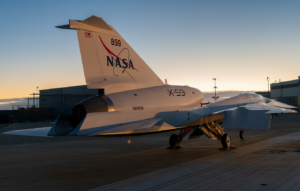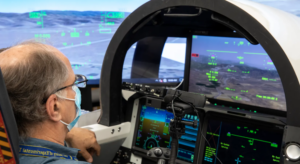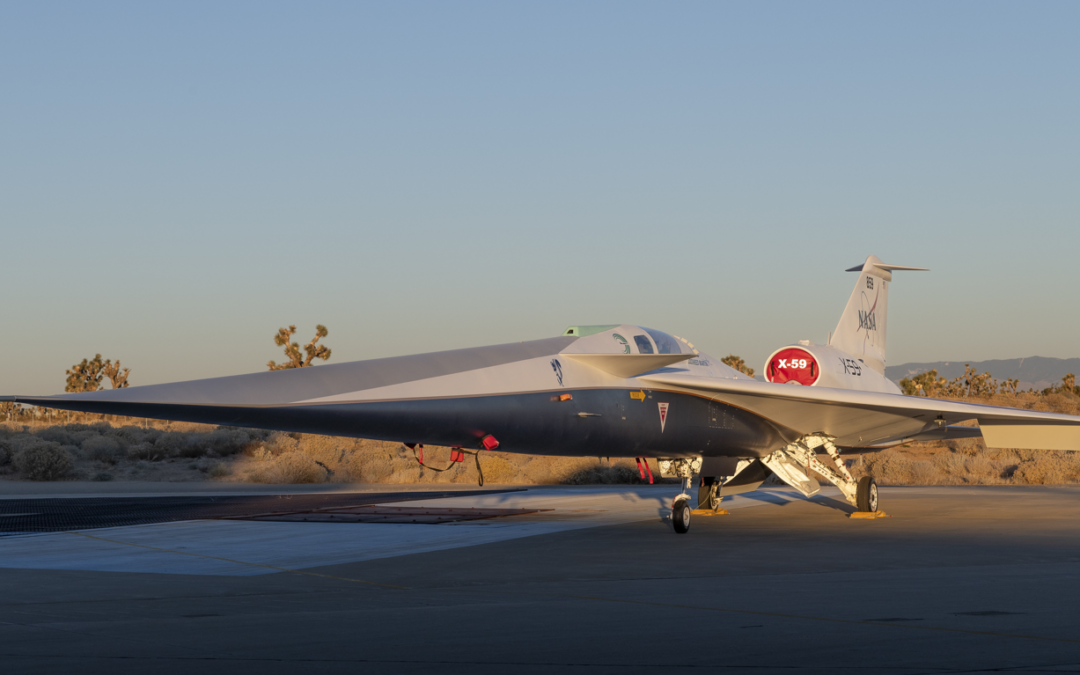NASA and Lockheed Martin formally unveiled their quiet supersonic aircraft, the X-59, on January 12, 2024. The aircraft will travel faster than the speed of sound at Mach 1.4 (925 mph). Mach being the ratio of the speed of the aircraft to the speed of sound through the air, named after 19th century physicist and shockwave studies contributor Ernst Mach. Lockheed Martin’s development program Skunk Works was selected by NASA in 2018 to design, build, and test the X-59. In just a few short years it has grown from an ambitious concept to a reality.
“NASA’s X-59 will help change the way we travel, bringing us closer together in much less time,” said NASA deputy administrator Pam Melroy. After a series of hurdles, supersonic travel may be revitalised through NASA’s Quesst mission.
Supersonic flight was tested throughout the mid-20th century before it was eventually banned in the US in 1973. The sonic boom – a shockwave with a sound akin to a loud explosion – was a persistent problem for such aircraft as it presented issues to the public and concern over potential property damage. Thus, the X-59’s elimination of the sonic boom will revolutionise the aircraft and bring it back into the fold of modern aircraft development 50 years after its ban.
Supersonic flight was first tested in 1947 with the Bell X-1 rocket-powered research aircraft. The test pilot was US Air Force Major Charles “Chuck” Yeager. The aircraft was dropped from a B-29 where it then broke the sound barrier travelling at 662 mph and reached a top speed of Mach 1.06 (700 mph). Yeager had successfully proven that humankind could travel Testing intensified from there with several supersonic military aircraft being developed, the issues of the sonic boom remaining in the periphery what with the testing grounds being far removed from affecting communities on the ground. At this time, the aircraft were unable to go beyond Mach 2.5 what with the friction causing damage to the plane’s lightweight aluminium surface. However, in 1973, after public opinion strongly opposing the sonic boom produced by the aircraft flying overhead of cities, a ban was put into effect. Limited technology at the time prevented the eradication of the sonic boom and thus supersonic travel in the US was put to the back burner.
Supersonic travel’s fate would be seemingly sealed across the globe in the following decades. The Soviet Tupolev Tu-144, which had its first flight on December 31, 1968, was the first commercial supersonic aircraft, which travelled at a speed of Mach 2 and then at 2.15 ten years later, the first supersonic aircraft to exceed Mach 2. It began commercial operations in 1975, carrying mail and cargo throughout Russia. Commercial passenger operations began in 1977 under Aeroflot, however it was withdrawn from commercial flight less than seven months later after a test flight crash landed. Its cargo operations continued until 1983 and was then primarily used as part of the Soviet space program to train pilots. The aircraft was eventually retired from operations entirely in 1999.
The Concorde aircraft suffered a more tragic fate. It was the first supersonic passenger-carrying commercial aircraft, beginning its passenger service in January 1976 for British Airways and Air France, mostly servicing Paris to Rio de Janeiro and London to Bahrain. The aircraft travelled at Mach 2.04 with 14 Concorde aircraft going into commercial service in total. Concorde began facing some issues with extremely high operating costs and ticket prices, which eventually led to cut routes with both airlines having New York City as its only regular destination, and the sonic boom proving unpopular. This all culminated on July 25, 2000, when the Concorde’s engine failed in a flight from Paris to New York City shortly after take-off. The Air France Flight 4590 crashed into a small hotel nearby. All 100 passengers and nine crew members along with four civilians by the hotel were tragically killed in the accident. The Concorde was grounded following the disaster, before returning to service in November 2001 after extensive variations to the airframe design but did not meet commercial success. The Concorde was eventually retired by Air France and British Airways in 2003.

Supersonic travel has faced its challenges but with technological advancements, will the X-59 reinvigorate a supersonic travel fever? NASA’s Quesst plan will use the X-59 as a research tool. The X-59 fly over several communities and gather data from these communities to gauge how they react to the aircraft. NASA will then provide that data to US regulators in the hopes of a new sound-based rule to amend the current ban on commercial supersonic flight over land. The X-59’s eradication of the sonic boom will, then, play a vital role in facilitating a future for supersonic travel in the US and perhaps beyond. “By demonstrating the possibility of quiet commercial supersonic travel over land, we seek to open new commercial markets for US companies and benefit travellers around the world,” said NASA associate administrator for aeronautics research Bob Pearce.
The X-59 was unveiled to much fanfare. Its striking elongated design certainly catches the attention with its protruding, sharp, and tapering nose, and its lack of front-facing windows; all of which were deliberate design choices to facilitate the eradication of the sonic boom. The single General Electric F414 engine, which Lockheed Martin X-59 programme lead David Richardson said was similar to the two F414 engines used in the Boeing F/A-18E/F Super Hornet supersonic aircraft, is also mounted on top of the aircraft to give the aircraft a smooth underside to help keep shockwaves from merging behind the aircraft. The engine was chosen for its ability to reach Mach 1.4 and is adequate for testing purposes without the necessity for developing a new engine. However, the limitations presented by this means that the life of the engine will be used rapidly throughout the tests.
The aircraft’s nose, which makes up a third of the aircraft’s length breaks up the shock waves. With this feature, the cockpit has also been fitted almost halfway down the length of the aircraft and does not feature front-facing windows to further negate the sonic boom. In its stead, the Quesst team has developed innovative technology to enable vision. The team developed the eXternal Vision Software (XVS), which is a series of external high-resolution cameras feeding a 4K monitor to the X-59 cockpit. Speaking to Aviation Life, NASA aerospace technologist and XVS lead Randy Bailey said the pilot “will see a combination of imagery that is the cameras that are located on the top and the bottom of the fuselage, as well as symbology information, like a standard head-up display.” He added that the goal of the system was to “provide equivalent levels of performance and safety” to forward facing windows. While the X-59 has not had its test flight yet, the XVS system has been tested successfully on other platforms.

Bailey added: “The advantages are we can control the image processing. So, unlike what you’ve got with real windows, whether you’re facing the sun, you can have some blinding conditions. We can do things with image processing that would actually make it better than what you can do out the window.”
Bailey added that making sure the electronics are reliable and safe is a key goal, but pilots can also rely on instrument piloting as a backup. He said: “What if we did lose XPS? What if we lost the forward vision system? What if we lost all of that? And they have gone through and proved that they can still fly the airplane and landed safely even if all of those vision systems failed.”
Pilots also took to the technology well, with Bailey stating that it “was very easy” to train pilots on the technology. He added: “It’s been evolving along in simulator testing, in and on the airplane testing. And so, they’re becoming very accepting of it. Obviously, they’re reserving their final judgment for when we actually fly it on the airplane.”
While the X-59 presents great strides in supersonic travel, the XVS software could present a “revolutionary” technological advancement for the aviation and aerospace industry. Bailey said: “If we can replace the need and requirement to put forward facing windows in, to locate the pilot on the front of the airplane, it opens up a new capability for designers to eliminate that constraint in how they fashion the fuselage of the airplane.”
He added: “Think about the fact that we operate airplanes under two sets of rules. One is instrument flight rules, one is visual flight rules. Really, the only difference is whether the pilot in the airplane can see out the windows or not. And so, if we can eliminate that paradigm, that would be amazingly revolutionary in our opinion. Whether that can happen is a long way off, but it’s still one of the goals that we’re trying to meet.”
The success of the X-59 hangs on its reception as the test flight is slated to roll out sometime later this year. Nevertheless, the technologies the NASA Quesst team have developed will be pivotal not only to the future of supersonic aircraft development but will inform important technological developments within the aviation industry.

